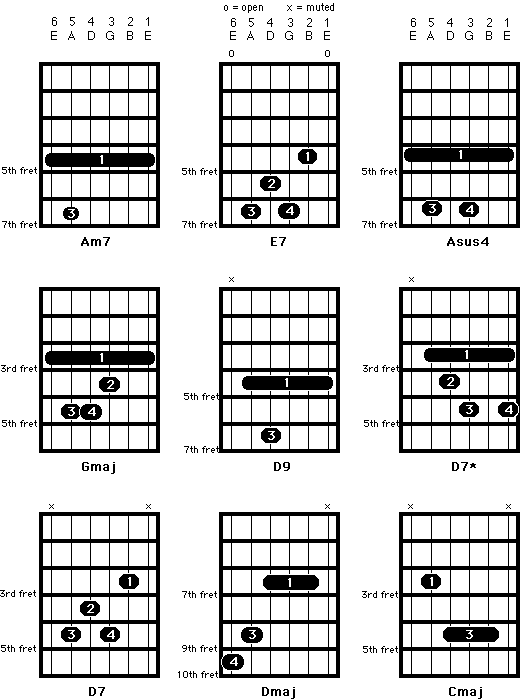|
INTRO: Am7 | Bm7/E7 |
Am7 | Bm7/E7 | Am7 | Bm7/E7 | Am7 | Bm7/E7 |
VERSE: Am7 | Bm7/E7 |
Am7 | Bm7/E7 | Asus4 | A maj | D9 | D9 |
CHORUS: G/D7* |
Bm7/Am7-D7 | G maj/Bm7 | C maj/ Dmaj |
G/D7* | Bm7/Am7-D7 | G
maj/Bm7 | C maj/ Dmaj | D-G/A-A | C-D |
I've included some
guitar chord diagrams,
but only show the basic different
types/inversions to be used. Use
the chords above for the correct order.
Although these chords can be played
in any inversion and work just fine,
if you use these ... you'll find that they
sound more like the record. I
assume you understand that Am7 (A minor
7th) (See chord illustration #1.) when
moved up the neck 2 frets (a whole
step) becomes a Bm7. I did not bother
to show the Bm7 diagram. The same
thing goes for Gmaj (G major) and
a Cmaj (C major), accept the Gmaj
is played barring behind the 3rd fret,
whereas a Cmaj would be played barring
behind the 8th fret.
E7 (E7th) = This is a
unique inversion in
as much as it uses the fingering similar
to an open C7 chord moved up
two whole steps to become an E7 chord,
with this exception. YOU ALSO LET
THE LOW and HI "E" STRINGS RING
OUT as open strings. The notes would
be (going low E string to hi E string)
... OPEN E, E, G#, D, E, OPEN E.
The open "E" on both the high and the
low strings gives a very nice ... pseudo-12
string effect to that passing chord. A
small thing, but really nice when done correctly.
See chord illustration
#2.
All major chords (see
illustration #4) signified by the letter name
or with the added suffix such as "Amaj" are to be
played as a standard 6
string bar chord similar to the Am7 description
above, except you put your second and fourth
fingers down on the
strings to make it a major chord instead of
minor 7th.
Concerning the second
half of each verse at the Asus4 chord passage
(see illustration #3). The first 3 chords of this
passage really just
accommodate the descending notes of D,
C#, and C. They are played as such: A 6 string bar
Amajor chord with
your little (4th) finger put on the 3rd string at the
7th fret. This is Asus4.
You're going to make that little finger note
go down in half steps with the next two chords. The
next chord is A maj. Just
lift your little finger off of the 3rd string-7th fret and
it will automatically be picked up
by the 2nd finger below it on the 6th fret. Move your 4th
finger back to the regular position for a 6 string
bar major chord. (4th
finger on the 4th string-7th fret)
For the 3rd chord (D9)
use the inversion in illustration #5. Starting with the 5th
string (A string) bar 5 strings with
your first finger on the 5th fret and add your 3rd finger to
the 4th string 7th fret. You play all the strings
but the low E string.
With all that changing of fingers all you've really done is
make that D note on the 3rd string
just descend in half steps. D, C#, and C notes. Note that
the low E string is muted.
THE CHORUS CHORDS: All
are the same inversions as above except for the D7* in the
first bar of the Chorus.
It's a strange little inversion and that's why I added an
asterist to it. It's an inversion that I only used
in this song and this
song alone. In fact, I didn't know this inversion. I just
made it up to create the flow that I
intended. You be the judge. It's a bit difficult at first,
but once you practice grabbing it repeatedly ... I
think you will
find it to have a special color and tonal quality that the
other D7's don't. The thing that is different
about it is that you
don't play the tonic on the low string. Instead, you play
the flatted 7th (C).
Chorus variables. On
the record I played rhythm guitar and then over-dubbed what
I call "Cropper Licks" referring
to Steve Cropper of Booker T. and the M.G.'s Steve used to
use a lot of those 2 note harmony things
around chord progressions. i.e. "Soul Man", etc. I applied
those to the Chorus section playing a "D"
note on my 3rd string 7th
fret and a high "B" note also on the 7th fret with my 2nd
and 3rd fingers respectively. Rather
than explain each one in the progression I'll just say that
I start with that one and all the others work
off of that
inversion.
I hope this helps
those of you who are interested. I did ramble a bit, but my
heart was in the right place.
Enjoy.
Michael
Allsup
|
